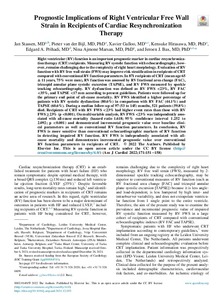Prognostic Implications of Right Ventricular Free Wall Strain in Recipients of Cardiac Resynchronization Therapy
Stassen Jan; van der Bijl Pieter; Galloo Xavier; Hirasawa Kensuke; Prihadi Edgard A; Marsan Nina Ajmone; Bax Jeroen J
https://urn.fi/URN:NBN:fi-fe2022081154248
Tiivistelmä
Right ventricular (RV) function is an important prognostic marker in cardiac resynchronization therapy (CRT) recipients. Measuring RV systolic function with echocardiography, however, remains challenging due to the complexity of right heart morphology. Evaluation of RV function with RV free wall strain (FWS) may improve risk stratification in recipients of CRT compared with conventional RV function parameters. In 871 recipients of CRT (mean age 65 ± 11 years, 75% were men), RV function was assessed by RV fractional area change (FAC), tricuspid annular plane systolic excursion (TAPSE), and RV FWS measured by speckle tracking echocardiography. RV dysfunction was defined as RV FWS <23%, RV FAC <35%, and TAPSE <17 mm according to present guidelines. Patients were followed up for the primary end point of all-cause mortality. RV FWS identified a higher percentage of patients with RV systolic dysfunction (80.6%) in comparison with RV FAC (44.1%) and TAPSE (60.6%). During a median follow-up of 97 (53 to 145) months, 521 patients (59.8%) died. Recipients of CRT with RV FWS <23% had higher event rates than those with RV FWS ≥23% (p <0.001). On multivariable analysis, RV FWS <23% was independently associated with all-cause mortality (hazard ratio 1.618; 95% confidence interval 1.252 to 2.092; p <0.001) and demonstrated incremental prognostic value over baseline clinical parameters as well as conventional RV function parameters. In conclusion, RV FWS is more sensitive than conventional echocardiographic markers of RV function in detecting impaired RV function. RV FWS is independently associated with all-cause mortality and demonstrates incremental prognostic value over conventional RV function parameters in recipients of CRT.
Kokoelmat
- Rinnakkaistallenteet [27094]
